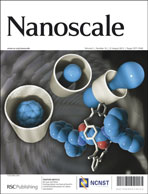Ratiometric highly sensitive luminescent nanothermometers working in the room temperature range. Applications to heat propagation in nanofluids†
Abstract
There is an increasing demand for accurate, non-invasive and self-reference temperature measurements as technology progresses into the nanoscale. This is particularly so in micro- and nanofluidics where the comprehension of heat transfer and thermal conductivity mechanisms can play a crucial role in areas as diverse as energy transfer and cell physiology. Here we present two luminescent ratiometric nanothermometers based on a magnetic core coated with an organosilica shell co-doped with Eu3+ and Tb3+ chelates. The design of the hybrid host and chelate


 Please wait while we load your content...
Please wait while we load your content...